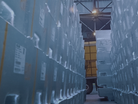Boliden starts sales of low carbon zinc

Boliden has started sales of low-carbon zinc and wants its climate-friendly product to account for 18% of total zinc production.
Low carbon SHG Zinc is mined at its own mines in Sweden and Ireland, using clean energy (click here for details). The new product emits less than one tonne of carbon dioxide emissions per tonne of zinc, compared with the industry average of 2.5 tonnes.
The main area of use for zinc is galvanization of steel structures, which protects against rust and extends the service life of the structures. Boliden claims it is Europe's largest mining producer in zinc and third largest in smelter production.
"The interest in metals with low climate impact is very high,” said Daniel Peltonen, director Business Area Smelters, Boliden. “We now include zinc in this product portfolio, which shows that our production of this metal is also at the highest level in terms of climate. In addition, investments are being made in increased production so that more metal with high climate performance comes to market.”
The first customers with a signed agreement for low carbon zinc are Zinkpower and EverZinc, and deliveries begin this month.
In parallel, a product from recycled zinc will also be offered. However, this zinc has a significantly higher climate impact due to the fact that the majority originates from a residual product from steel production and available recycling technology.
The emission calculations include emissions along the entire value chain up to the customer according to Scope 1, 2 and 3 GHG Protocol Product Life Cycle and follow the standard ISO 14064-3.
In 2021, Boliden presented corresponding products in copper, which was well received by the market. For copper, the limit value is 1.5 tonnes of CO2 per tonne of copper, compared with the global average of around 4 tonnes of CO2.
Mining is currently responsible for 4-7% of greenhouse-gas emissions globally. Scope 1 and Scope 2 emissions from the sector (those incurred through mining operations and power consumption, respectively) amount to 1%, and fugitive-methane emissions from coal mining are estimated at 3-6%.
• Join global business leaders and sustainability experts who are taking meaningful action at Sustainability LIVE, at Tobacco Dock, London, 23-24 February 2022. Register your attendance today. Click here to discover more.



